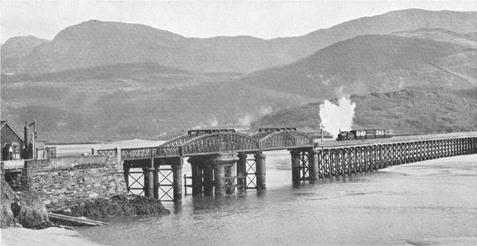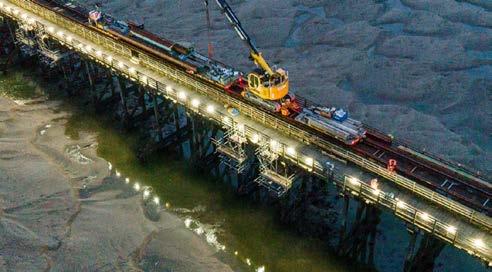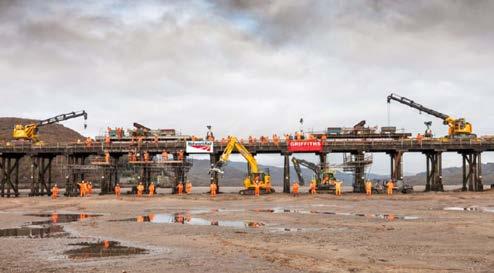
12 minute read
Undergoes a Major Restoration
Barmouth Bridge (Pont Abermaw) Undergoes a Major Restoration
This well-known structure is now a Grade II* listed structure. It provides a single track on a wooden railway viaduct across the estuary of the Afon Mawddach near Barmouth in north Wales. At 900 yards long, it is the longest timber viaduct in Wales and one of the longest in regular use in Britain and carries the Cambrian line over the river.
Advertisement
Barmouth Bridge was designed by and constructed for the Aberystwith and Welsh Coast Railway on its line between Aberystwyth and Pwllheli. Work was authorised in 1861 and commenced in 1864. On 10 October 1867, the completed bridge was officially opened. Following the discovery of severe corrosion on underwater sections of ironwork, an intensive restoration programme was performed between December 1899 and late 1902. By 1980, the viaduct was under attack by marine woodworm, which led to concerns that it would have to be closed and demolished. Because of its value to tourism, it was repaired between 1985 and 1986, a closure of six months; a weight restriction and ban on locomotivehauled trains were also introduced. These restrictions have been relaxed since 2005. The viaduct, between Morfa Mawddach and Barmouth stations in Gwynedd, is used by rail, cyclists and pedestrians and is part of National Cycle Route 8. Tolls were collected for foot and cycle traffic up to 2013 but this has been voluntary since 2017. To allow the passage of tall ships, the bridge incorporated a drawbridge, which was replaced between 1899 and 1902 by a swing bridge, which is no longer operational due to a lack of use. There is no provision for road traffic. The Cambrian Coast Line was operated by Arriva Trains Wales until 2018, and is now operated by Transport for Wales, which provides connecting services north to Pwllheli
By OLU, CC BY-SA 2.0, https://commons.wikimedia. and east to Machynlleth, Shrewsbury and org/w/index.php?curid=13127458 Birmingham International. 20 GREAT WESTERN STAR MAGAZINE January/February 2021


A steam-hauled train crossing Barmouth Bridge in 1921
View of the bridge from the northwest in 2014 The bridge in 2020 showing the severe deterioration Construction of the Bridge
The timber section of the bridge is 764 yd long and is made up of 113 wooden trestles, each about 6.0 yd span, supported by cast iron piers. Most of the bridge is built on top of a gravel bed, covered by shifting sand. The northern end of the viaduct, where the swing bridge is located, is next to Figle Fawr, a rock at the base of the Rhinogydd mountains. Water passing through the channel flows at up to 9 knots (10 mph). The first two spans at this end are built on the rock on cast iron cylindrical piers. The steel swing bridge section,


which replaced the original drawbridge, was last opened (for testing) in April 1987. The installation of continuous rail across the movable section now prevents its movement and the passage of tall ships in and out of the estuary. All mechanisms associated with the swing bridge, however, are left in situ, in accordance with the Grade II* listing of the structure.
Barmouth Bridge was designed by the civil engineers Benjamin Piercy and Henry Conybeare in 1864. Conybeare decided on the use of a timber viaduct because it was about four times cheaper to import wood from the Baltic by sea than to construct an iron bridge. The decision was influenced by the incorrect belief that the estuary was free from marine borers (a mollusc or crustacean that lives usually in warm seas and destroys wood by boring into and eating it. The gribble and shipworm are the best known since they penetrate any wood in favourable water), which attack and weaken the timber over time. During this era, timber pile viaducts were commonplace on British coastal railways, although the bridge at Barmouth would be longer than most.
Construction began in 1864; the contractor was Thomas Savin, and the ironwork was produced by John Cochrane & Sons. Early on, progress was hindered by strong tidal currents which caused multiple failed attempts to sink the bridge's piers from barges. Between March and June 1866, staging was built from the northern abutment for the bridge, and the piers were dropped into the water, bedded into the rock, and filled with concrete.
Wooden trestles were built on screw piles 10-14 inches wide with screw discs 36 inches in diameter in groups of three piles per pier. Timber trellis girders, 40 feet long and 4 feet deep, supported the deck, with driven piles as fenders. The water around the trestles had a maximum depth of 54 feet at spring tides but the river bed was raised by tipping stones to protect the piles.
The viaduct had a 47 feet wooden drawbridge near its northern end, allowing tall ships to pass upstream. The drawbridge span, which was carried on top of wrought iron piles, opened by tilting and rolling back over the track on four 4 feet wheels, spaced 50 feet apart, and nine steel rollers. When opened, there was a 36 feet gap between the fenders. The drawbridge was never used on a regular basis as the opening of the railway effectively eliminated the need for traditional boat traffic.
From 3 June 1867, the viaduct was opened for horse-drawn carriages to cross, and then, on 10 October, the bridge was officially opened, and steam-hauled services started using the track.
In August 1899, Alfred Jones Collin, the chief engineer of Cambrian Railways (which had absorbed the A&WCR in 1865), ordered underwater inspections to check the integrity of the drawbridge span’s ironwork. They discovered that the supports were severely corroded, undermining its structural integrity and requiring the replacement of all the ironwork except for two piers. Repairs started that December and were completed by the end of 1902. The drawbridge was replaced with a swing bridge with a 136 ft long single steel swing span, which rotated around a central pivot, close to a 118 ft long fixed span. The spans are hogback-shaped lattice trusses, supported by pairs of cylindrical iron piers, and the turntable rests on a cluster of four piers.
20th century
In 1946, the bridge was nearly destroyed after a live naval mine was washed ashore close to it during stormy weather. According to reports, the mine had swept past one of the pillars, but did not detonate and the bridge escaped unscathed.
Following the Beeching cuts of the 1960s, passenger train services through Barmouth declined following the closure of the Ruabon to Barmouth line via Llangollen and Dolgellau in 1965, causing all traffic to take the longer and slower route from Shrewsbury via Machynlleth and Dovey Junction. The old trackbed from Morfa Mawddach railway station to Dolgellau now forms the Mawddach Trail, a walking and cycle trail.
By 1980, the bridge's 500 timber trestle piles were under attack from marine woodworm at river bed level and the resulting damage was serious enough to threaten its closure. British Rail divers discovered that the woodworm had eaten into 69 of the supporting pillars and estimated that it would cost around £2.5 million to repair. On 13th October 1980, the viaduct was temporarily closed to rail traffic, following which locomotive-hauled trains were banned, which resulted in the loss of traffic from Tywyn, including explosives traffic to and from the factory at Penrhyndeudraeth which was re-routed via Maentwrog Road railway station and the Conwy Valley Line.


Work in progress in 2020
Gwynedd County Council opposed permanently closing the bridge as 40% of all tourism in the area was rail related. The government applied for a £2.5 million grant from the European Economic Community (EEC) to finance repairs, and £4.6 million was spent on signalling improvements upon the line. In 1985–1986, the bridge was closed to traffic again for a seven month period during the repair works, which entailed replacing 48 of the piles with greenheart hardwood. Others were encased and strengthened with grout and glass-reinforced concrete shrouds. Within the trestles, wailing timbers and diagonals were replaced with Douglas fir timber. Rail services resumed when the viaduct reopened in April 1986. On 13 April 1986, a British Rail Class 37 diesel locomotive number 37427 was named Bont Y Bermo (Welsh for Barmouth Bridge) to celebrate the reintroduction of locomotivehauled trains following repairs. Locomotivehauled trains were again forbidden shortly afterwards as weight restrictions were imposed upon all bridge traffic.

An old picture of the bridge with the span rotated to allow a boat to pass through
21st century
After major repairs in 2005, the weight restriction was finally relaxed, and locomotivehauled trains once more allowed to cross. In March 2013, the Barmouth Viaduct Access Group (B-VAG), was established to investigate an alternative route from the town centre to the bridge, as the walkway is steep, narrow, and unsuitable for pushchairs or wheelchairs. In June, the bridge toll was removed after the collectors left and were not replaced. The council was undecided as to how to pay for maintenance costs, which were £39,405 for the year. This is problematic as revenue from tolls is insufficient to cover the council's share of costs, and there is no budget to employ staff to collect payments.
Gwynedd Council proposed closing the bridge to pedestrians and cyclists for cost reasons, as it needed to find £9 million of savings by April 2016. Closing the bridge is one of over 100 cost saving options totalling £13 million that were put to a public consultation in Autumn 2015. The council pays Network Rail £30,800 per year towards maintenance costs. A petition calling on the council to "cease considerations of closing this much-loved walking and cycling route" attracted 20,000 signatures in a week. In February 2016, it was reported that the bridge would not close.
On 4 October 2016, Barmouth Bridge was closed to traffic for a week following a fire on the structure. The following day, Liz Saville Roberts MP called for its speedy renovation as a matter of urgency.
In October 2017, the viaduct celebrated its 150th anniversary with a fireworks display and special charter trains were run. The same month, Bill Kelly, the chief operating officer of Network Rail Wales, spoke of unapproved ambitions to spend around £20 million to secure the long-term future of Barmouth Bridge between 2019 and 2024. In late 2017, an "honesty toll" of £1 for adults and 50p for children was introduced with a troll mascot, and the old toll house rebranded as a "troll house".
In December 2018, it was reported that the future of the bridge was once again in doubt, but a £25 million 3-year restoration project was announced by Network Rail in May 2020. Network Rail had considered building a new bridge, involving significant groundwork and piling, but chose refurbishment because timber is lighter, and the 1867 structure is considered iconic.

An aerial view of the bay, showing the bridge across the river to Barmouth. In the bottom left hand corner is the loop of the Fairbourn Railway
2020 onwards
The restoration will replace on a like-forlike basis a large number of timber elements of the viaduct, the metallic spans of the viaduct, as well as the entire 2,690 ft length of track across it. The swinging elements of the bridge are not to be restored, but all key mechanisms associated with the swing bridge will be retained in situ in accordance with the 1988 Grade II* listing of the structure. The work will not speed up journeys along the line; the viaduct's long lateral structure gives it limited stability, meaning that maximum speeds of 20 mph for passenger trains and 10 mph for freight will remain. FSC-certified greenheart hardwood was sourced by Network Rail from Guyana for its long track record of use in challenging applications, and preservative treatment is unnessary as it is resistant to attack by shipworm and wood rotting fungi.
The first phase of the project was completed in November 2020. The next two of the three planned closures are scheduled for September to December 2021 and October to December 2022. The original iron rolling centre section was replaced by a steel lattice swing bridge in 1899. The later structure has two hogback trusses on cylindrical piers, one of which is a swing span of 136 feet and the other is a fixed span. The wooden bridge was replaced by 113 openings of 18 feet span on timber pile trestles which are now encased in glass-fibre
Network Rail’s Commitment
A spokesman said, “We know how much the iconic Barmouth Viaduct means to the community and the local economy. Our £25m restoration is the biggest upgrade in the viaduct’s history. This will help protect our industrial heritage and safeguard this vital transport link so it can continue to serve local people and attract visitors to the area for generations to come. At over 150 years old, the viaduct is currently in poor condition. Many of the timber elements of the viaduct have decayed significantly over time and a large proportion of the metallic elements have corroded. Our programme will see us completely restoring the viaduct in a way that does not threaten its industrial heritage and its Grade II* listed status. This means that we will replace its components on a ‘like-for-like’ basis so that it retains its magnificent appearance. We’ve been working closely with Cadw, Gwynedd County Council and other stakeholders over several years to develop and agree our plans.”
“To reduce the impact on the local community and tourism in Barmouth, we’ve carefully planned our work to take place over three years - with three shorter full closures of the viaduct, rather than one longer full closure. We began setting up site in June 2020 and have been carrying out preparation work since then. The following information provides an overview of our current planned timescales. We’ll start










